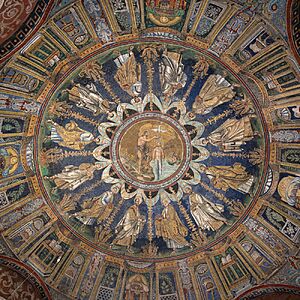Baptistery of Neon facts for kids
The Baptistery of Neon is a very old and important building in Ravenna, a city in northeastern Italy. It's one of the oldest buildings still standing in Ravenna! It was even built partly on top of an old Roman bath house. People also call it the Orthodox Baptistery. This helps tell it apart from another baptistery, the Arian Baptistery, which was built about 50 years later by King Theodoric.
Contents
History of the Baptistery
This special building is shaped like an octagon and is made of brick. It was started a long, long time ago, around the late 300s or early 400s. A religious leader named Bishop Ursus began building it. It was part of a much bigger church that doesn't exist anymore.
The Baptistery was finally finished by another Bishop named Neon. This happened later, around the end of the 400s. That's when the beautiful mosaic pictures were added to the ceiling.
What the Baptistery Looks Like
The original floor of the Baptistery is now about 3 meters (or 10 feet) underground. This means we can't see the building's full original height today.
The Octagonal Shape
The building has eight sides, which is called an octagonal shape. Many early Christian baptisteries were built this way. The eight sides are a special symbol. They represent the seven days of the week, plus an eighth day for the Day of the Resurrection and eternal life.
The Amazing Ceiling Mosaic
The most famous part of the Baptistery is its ceiling mosaic. A mosaic is a picture made from tiny pieces of colored glass or stone. This mosaic shows a very important scene: John the Baptist baptizing Jesus. Jesus is shown with a beard and is standing in the Jordan River up to his waist.
You can also see a figure representing the Jordan River itself, like a river god. Around this central picture, there's a procession of the twelve apostles. They are walking in two groups, and they meet in the middle. At the meeting point, you can see Saint Peter and Saint Paul.
A World Heritage Site
The Baptistery of Neon is one of eight buildings in Ravenna that are recognized by UNESCO as World Heritage Sites. This means they are very important places that should be protected for everyone to see. Experts say it's the best and most complete example of an early Christian baptistery that still exists today. They also admire how the human figures in the mosaics look so natural, like art from ancient Greece and Rome.



